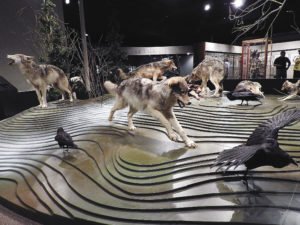Separating fact and fiction with the help of the International Wolf Center
Ely—Unlike some animal-based tour attractions, the International Wolf Center in Ely focuses on education. The gray wolves featured for public viewing are enticing, but what sets the center apart is the vast information displayed to help us stop viewing the wolf as good or evil and begin to understand the complexities of this beautiful creature.
Through time, the wolf has been surrounded in mystery and darkness, leading to many unfounded fears and negative perceptions of this animal. The travelling human/wolf exhibit found its permanent home in Ely in 1993 when the facility opened to the public. The indoor display features an elaborate taxidermy showcase surrounded by audio and visual material breaking down wolf behaviour, myths and the relationship between wolf and man over time.
The staff at the International Wolf Center are well-educated and their passion for sharing their knowledge to the public is evident upon meeting them. The main attraction is the chance to view up to five wolves, including three of the five subspecies (Great Plains wolf, Northwestern gray wolf and the Arctic wolf). The employees engage the animals in regular activities to encourage visibility to the public without forcing them to be on display.
“The pups are raised with people 24 hours a day with wolf care staff and volunteers for the first three months before they are introduced to the pack and outdoor exhibit,” wolf center manager, Krista Harrington, explains. “We socialize our wolves to minimize their stress and fear of people. They are still wild and not domesticated by any means, but they have gone through the socialization process so that it is not stressful to be in the exhibit. You can see normal wolf behaviours that you wouldn’t see in the wild because they have a very strong fear avoidance of people. In the wild, it is very rare to see them and if you do, they tend to run away. So socializing them minimizes that fear.”
Due to mythology, folklore, and other influences, we have been taught that we have a reason to fear the wolf. The reality is that a wolf attack is extremely rare. Even in areas where packs had little to no human contact, including Isle Royale National Park on Lake Superior, they still displayed a strong aversion to human interaction.

Many members of the hunting and farming community have a negative outlook on the wolf due to depredation of livestock, as well as pets and predation of the ungulate population. A common misconception held by both is that wolves kill for fun. It may seem like it when a pack takes out more than it can eat at that moment. This is called a surplus killing and it has more to do with opportunity than it does killing for sport. If the option remains, they will return to the kill to eat over several weeks. Over a five-year period, on average there are about 70 annual complaints of depredation of livestock due to wolves.
“In Minnesota, the population of ungulates has stayed steady. We have about 2,200 wolves and just over 1 million deer. Those numbers have been stable for quite some time,” said Harrington. “The moose population has been on the decline but there is a lot of research being done as to the reasons why this is happening. Predation is certainly one of them, but disease, changes in climate and habitat, could also be playing a factor in the decline as well.”
The reasons behind howling have also been misinterpreted overtime. There is no scientific evidence that there is an increase in howling in regards to the fullness of the moon. The only purpose of howling is communication. This can be to locate other members of the pack, to reinforce the bond of the pack or to defend their territory from other wolves.
In addition to the exhibit, the International Wolf Center offers a variety of unique and interactive adventure programs that you can participate in. For more information, visit: wolf.org.—Nicole Lewis






